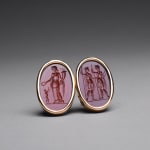Gold Earrings Featuring Two Classical Revival Intaglios of Roman Soldiers, 1700 CE - 1800 CE
Carnelian and Gold
FJ.6446
Further images
Two classical revival carnelian intaglios depicting 1) Two Roman soldiers 2) Fecunditas and chil These Intaglios are Set in 18 Karat Gold Earrings The art of glyptics, or carving on...
Two classical revival carnelian intaglios depicting 1) Two Roman soldiers 2) Fecunditas and chil
These Intaglios are Set in 18 Karat Gold Earrings
The art of glyptics, or carving on colored precious stones, is probably one of the oldest known to humanity. Intaglios, gems with an incised design, were made as early as the fourth and third millennia BC in Mesopotamia and Aegean Islands. They display a virtuosity of execution that suggests an old and stable tradition rooted in the earliest centuries. The tools required for carving gems were simple: a wheel with a belt-drive and a set of drills. Abrasives were necessary since the minerals used were too hard for a metal edge. A special difficulty of engraving intaglios, aside from their miniature size, was that the master had to work with a mirror-image in mind.
Stimulated by a renewed interest in classical antiquities among the wealthy classes, engravers sought subject matter and inspiration from the study of ancient coins. These two delightful intaglios offer an excellent example of such research. On one there are two fully armed Roman soldiers holding spears, the soldier at left presenting a wreath of victory to the other. The goddess Fecunditas adorns the second intaglio, wearing a stola, holding a cornucopia and wreath which she extends over the head of a young boy who is reaching for it with outstretched arms. This scene is similar to one found on a coin of the empress Julia Mamaea, (mother of Severus Alexander A.D.222-235). It is interesting that both intaglios feature wreaths in a different context-- as a symbol of victory in war, and a representation of the bounty of many children through fecundity.
These Intaglios are Set in 18 Karat Gold Earrings
The art of glyptics, or carving on colored precious stones, is probably one of the oldest known to humanity. Intaglios, gems with an incised design, were made as early as the fourth and third millennia BC in Mesopotamia and Aegean Islands. They display a virtuosity of execution that suggests an old and stable tradition rooted in the earliest centuries. The tools required for carving gems were simple: a wheel with a belt-drive and a set of drills. Abrasives were necessary since the minerals used were too hard for a metal edge. A special difficulty of engraving intaglios, aside from their miniature size, was that the master had to work with a mirror-image in mind.
Stimulated by a renewed interest in classical antiquities among the wealthy classes, engravers sought subject matter and inspiration from the study of ancient coins. These two delightful intaglios offer an excellent example of such research. On one there are two fully armed Roman soldiers holding spears, the soldier at left presenting a wreath of victory to the other. The goddess Fecunditas adorns the second intaglio, wearing a stola, holding a cornucopia and wreath which she extends over the head of a young boy who is reaching for it with outstretched arms. This scene is similar to one found on a coin of the empress Julia Mamaea, (mother of Severus Alexander A.D.222-235). It is interesting that both intaglios feature wreaths in a different context-- as a symbol of victory in war, and a representation of the bounty of many children through fecundity.





